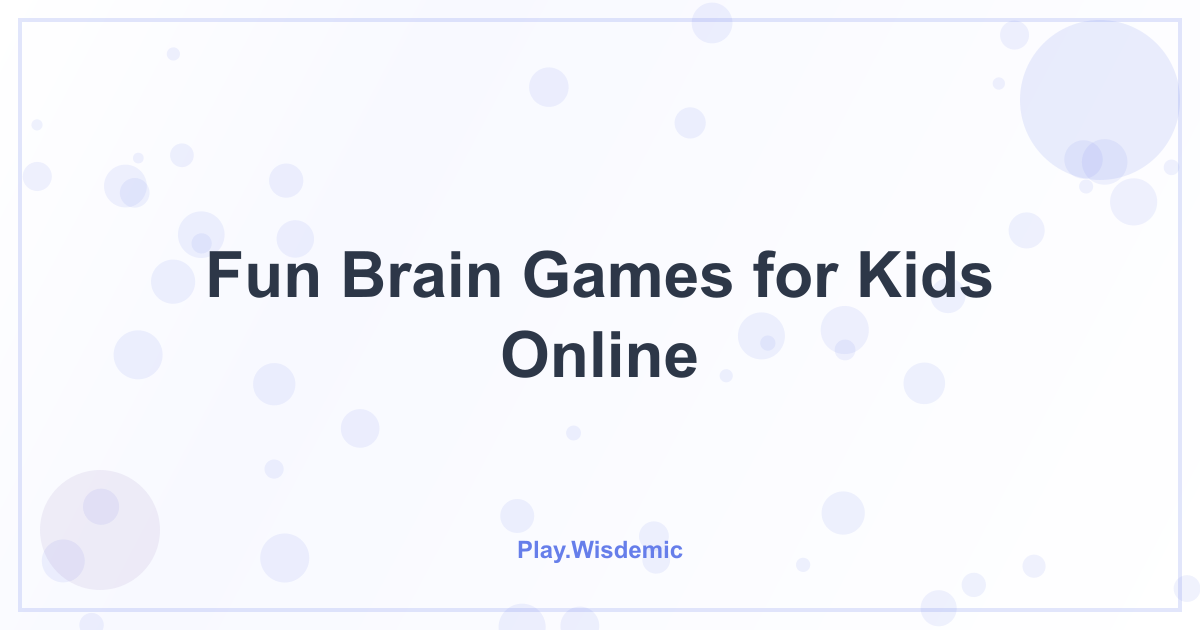Kids learn best when they're having fun—especially when glowing screens are involved. As a mom of two whirlwind explorers (an eight-year-old puzzle master and a four-year-old button-tapping enthusiast), I've seen first-hand how the right online brain games can turn a "five-minute tech break" into half an hour of genuine discovery. The challenge isn't finding games—there are thousands—but rather sorting the brain-boosting gems from the digital junk food. In this guide we'll dive deep into the benefits of brain games, how to vet titles like a pro, and the small tweaks that will help your child squeeze every last drop of learning out of play time.
Why Brain Games Deserve a Spot in Your Routine
Neuroscientists call childhood a period of "rapid synaptic pruning"—connections fire, pathways are chosen, and the brain trims what it doesn't use. Purposeful digital play keeps critical pathways alive by stretching working memory, attention switching, and spatial reasoning. A well-designed logic maze, for example, asks children to plan ahead, predict outcomes, and revise strategy on the fly—skills that translate directly to reading comprehension and problem solving in the classroom.
Parents also benefit: quiet, focused game sessions can buy you 20 guilt-free minutes to prep dinner or help an older sibling with homework. Win-win!
6 Checkpoints for Choosing Online Brain Games
- Open-Ended Challenges. Avoid one-route puzzles; multiple solutions encourage divergent thinking.
- Age-Appropriate Visuals. Skip neon overload. Clean interfaces help kids focus on the thinking, not the bling.
- Short, Progressive Levels. Young minds need quick wins paired with a steady sense of growth—our golden recipe at Play.Wisdemic.
- Adaptive Difficulty. Look for games that note streaks and automatically step up the challenge.
- Low or No Ads. Distractions shatter concentration and can expose kids to questionable content.
- Transparent Learning Goals. The description should state which skills are targeted—memory, logic, math, language—so you can align with your child's needs.
Top 7 Brain-Boosting Game Styles (with Examples)
- Pattern Sequencers. "Repeat this color/shape line" trains visual memory and introductory algebra thinking.
- Path-Finding Mazes. Build neural maps for spatial awareness—our Logic Lanes levels are a parent favorite.
- Match-Three Strategy Grids. Contrary to belief, these teach planning when limited moves are introduced.
- Number Bond Puzzles. Combine tiles that add up to 10, 20, or 100—fantastic for mental math fluency.
- Memory Flip Cards. Classic, but when you layer thematic content (e.g., planets, fractions) it doubles learning.
- Odd-One-Out Challenges. Perfect for honing categorisation and early scientific classification.
- Story-Driven Quests. Narrative hooks boost intrinsic motivation, helping kids persist through tougher levels.
How Play.Wisdemic Lifts the Bar
We built Play.Wisdemic because we were fed up with banner ads and noisy interfaces. Our adaptive engine watches time-to-solve and error patterns to tweak complexity in real time—so boredom and frustration never get a foothold. The parent dashboard translates performance data into plain-English insights like "Ava solves sequential puzzles 18% faster than last week."
Favorite In-App Brain Games
- Pattern Puzzler. Expands from ABAB color strings to intricate nested sequences.
- Speedy Sums. Combines arcade timers with addition/subtraction drills for lightning mental math.
- Shape Shift. Drag shapes into rotating silhouettes—fantastic for 3-D spatial reasoning.
Creating a Healthy Screen-Time Rhythm
The American Academy of Pediatrics recommends structured limits and high-quality content. In our home we follow the 20-20-20 rule: for every 20 minutes of screen play, look 20 feet away for 20 seconds—then hop up for a stretch. Brain games are most powerful in 10- to 15-minute bursts, two to three times per day.
Quick Parent Checklist
- Preview the game yourself for at least five minutes.
- Turn on "guided access" (iOS) or "app pinning" (Android) so curious taps don't wander off.
- Celebrate process (“I love how you tried a new path!”) more than score.
- Pair digital wins with real-world extensions: recreate a digital maze with LEGO bricks.
Real talk: last Tuesday my son begged for extra tablet time. I challenged him to beat his personal best in Speedy Sums. Ten minutes later he emerged beaming—he'd shaved four seconds off and unlocked a confetti animation. We printed the certificate, stuck it on the fridge, and he spent the next hour racing toy cars while chanting math facts. Screens can spark off-screen learning when handled thoughtfully.
FAQ
Isn't online play just more screen time?
Balanced, goal-oriented play counts as active learning. Pair short bursts with movement breaks to keep eyes and bodies fresh.
How can I verify educational value quickly?
Check for clear skill tags, parental dashboards, and absence of click-bait ads.
Are competitive leaderboards okay?
Yes—when they spotlight personal growth rather than global rankings. Our "personal best" tracker keeps pressure positive.
What if my child gets stuck and frustrated?
Model a thinking-aloud strategy: verbalise your reasoning steps on the first level, then let them take the reins.
Ready to see playful learning in action? Explore our adaptive brain games and watch your child's confidence bloom—no signup required for the first five levels!
